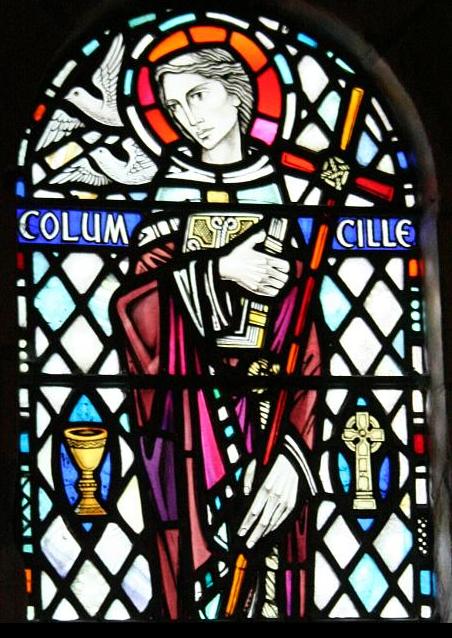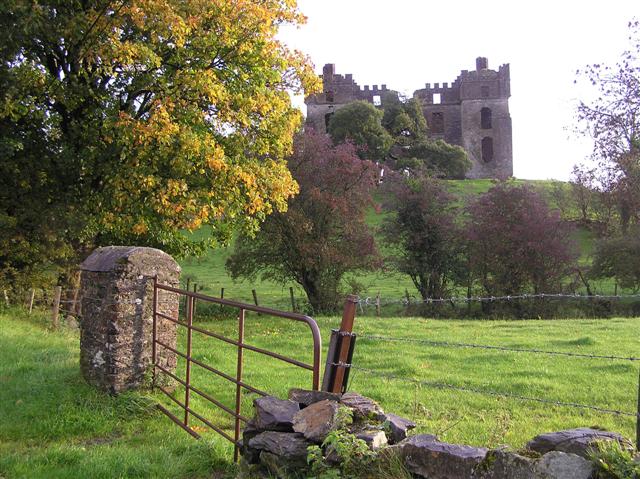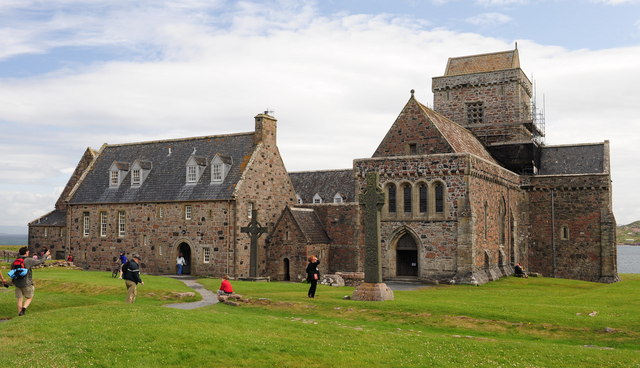|
Adomnán
Adomnán or Adamnán of Iona (, la, Adamnanus, Adomnanus; 624 – 704), also known as Eunan ( ; from ), was an abbot of Iona Abbey ( 679–704), hagiographer, statesman, canon jurist, and saint. He was the author of the ''Life of Columba'' ( la, Vita Columbae), probably written between 697 and 700. This biography is by far the most important surviving work written in early-medieval Scotland, and is a vital source for our knowledge of the Picts, and an insight into the life of Iona and the early-medieval Gaelic monk. Adomnán promulgated the Law of Adomnán or "Law of Innocents" ( la, Lex Innocentium). He also wrote the treatise ('On Holy Places'), an account of the great Christian holy places and centres of pilgrimage. Adomnán got much of his information from a Frankish bishop called Arculf, who had personally visited Egypt, Rome, Constantinople and the Holy Land, and visited Iona afterwards. Life Adomnán was born about 624, a relative on his father's si ... [...More Info...] [...Related Items...] OR: [Wikipedia] [Google] [Baidu] |
Cáin Adomnáin
The ''Cáin Adomnáin'' (Law of Adomnán), also known as the ''Lex Innocentium'' (Law of Innocents), was promulgated amongst a gathering of Irish, Dál Riatan and Pictish notables at the Synod of Birr in 697. It is named after its initiator Adomnán of Iona, ninth Abbot of Iona after St. Columba. It is called the "Geneva Accords" of the ancient Irish and Europe's human rights treaty, for its protection of women and non-combatants, extending the Law of Patrick, which protected monks, to civilians. The legal symposium at the Synod of Birr was prompted when Adomnáin had an Aisling dream vision wherein his mother excoriated him for not protecting the women and children of Ireland. History During almost two centuries, and more precisely the years 697-887, nine different ordinances were promulgated and kept in the record of the annals of Ireland. Each ordinance was issued either by a saint or monastic group. Three texts of these legislations have come to us, the earliest being C ... [...More Info...] [...Related Items...] OR: [Wikipedia] [Google] [Baidu] |
Dál Riata
Dál Riata or Dál Riada (also Dalriada) () was a Gaelic kingdom that encompassed the western seaboard of Scotland and north-eastern Ireland, on each side of the North Channel. At its height in the 6th and 7th centuries, it covered what is now Argyll ("Coast of the Gaels") in Scotland and part of County Antrim in Northern Ireland.Clancy, Thomas Owen, "Philosopher King: Nechtan mac Der Ilei," SHR 83 (2004): 135–149 After a period of expansion, Dál Riata eventually became associated with the Gaelic Kingdom of Alba.Oxford Companion to Scottish History pp. 161–162, edited by Michael Lynch, Oxford University Press. . In Argyll, it consisted of four main kindreds, each with their own chief: Cenél nGabráin (based in Kintyre), Cenél nÓengusa (based on Islay), Cenél Loairn (who gave their name to the district of Lorn) and Cenél Comgaill (who gave their name to Cowal). The hillfort of Dunadd is believed to have been its capital. Other royal forts included Dunollie, ... [...More Info...] [...Related Items...] OR: [Wikipedia] [Google] [Baidu] |
Life Of Columba
The ''Life of Columba'' ( la, Vita Columbae) is a hagiography recounting the life of Columba, the founder of Iona Abbey, written a century after Columba's death by Adomnán, one of his successors as Abbot of Iona. Adomnán (also known as Eunan), served as the ninth Abbot of Iona until his death in 704. James Earle Fraser asserts that Adomnán drew extensively from an existing body of accounts regarding the life of Columba, including a Latin collection entitled "De uirtutibus sancti Columbae", composed c. 640 A.D. This earlier work is attributed to Cummene Find, who became the abbot of Iona and served as the leader of the monastic island community from 656 until his death in 668 or 669 A.D. While the ''Vita Columbae'' often conflicts with contemporaneous accounts of various battles, figures, and dates, it remains the most important surviving work from early medieval Scotland and provides a wealth of knowledge regarding the Picts and other ethnic and political groups from this t ... [...More Info...] [...Related Items...] OR: [Wikipedia] [Google] [Baidu] |
Fáilbe Mac Pípáin
Fáilbe mac Pípáin was the eighth abbot of Iona ( 669–679). Fáilbe was of the same kindred as Columba, the Cenél Conaill, distantly related to him through their common ancestor Conall Gulban Conall Gulban (died c. 464) was an Irish king and eponymous ancestor of the '' Cenél Conaill'', who founded the kingdom of ''Tír Chonaill'' in the 5th century, comprising much of what is now County Donegal in Ulster. He was the son of Niall N .... We know from the writings of Adomnán that Fáilbe was at Iona when King Oswald of Northumbria visited sometime in the 630s and was also present when Saint Ernéne, son of Crasen, visited before his death in 635. Little is known of his abbacy, but we do know he enjoyed a good relationship with his monk and successor, Adomnán, to whom he relayed information. Fáilbe died on 22 March 679. Bibliography * Sharpe, Richard, ''Adomnán of Iona: Life of St. Columba'', (London, 1995) 679 deaths Abbots of Iona 7th-century Irish abbo ... [...More Info...] [...Related Items...] OR: [Wikipedia] [Google] [Baidu] |
Arculf
Arculf (later 7th century) was a Frankish bishop who toured the Levant in around 680. Bede claimed he was a bishop (). According to Bede's history of the Church in England (V, 15), Arculf was shipwrecked on the shore of Iona, Scotland on his return from a pilgrimage to the Holy Land. He was hospitably received by Adomnán, the abbot of the island monastery from 679 to 704, to whom he gave a detailed narrative of his travels. Adomnán, with aid from some further sources, was able to produce '' De Locis Sanctis'' ("Concerning the sacred places"), a descriptive work in three books dealing with Jerusalem, Bethlehem, and other places in Palestine, and briefly with Alexandria and Constantinople. Bede learned of this and spoke about him in his ''Ecclesiastical History of the English People''. Many details about Arculf's journeys can be inferred from this text. Modern references Arculf appears briefly as a character in the novel ''Justinian'' by H. N. Turteltaub (Harry Turtledove). See a ... [...More Info...] [...Related Items...] OR: [Wikipedia] [Google] [Baidu] |
Roman Catholic Diocese Of Raphoe
:''See Diocese of Derry and Raphoe for the Anglican (Church of Ireland) counterpart The Diocese of Raphoe ( ; ga, Deoise Ráth Bhoth) is a Latin Church ecclesiastical territory or diocese of the Catholic Church in County Donegal in Ulster, Ireland. It is one of eight suffragan dioceses in the inter-Irish primatial ecclesiastical province of the metropolitan Archdiocese of Armagh.Archdiocese of Armagh Retrieved on 16 January 2009. On 9 June 2017, was appointed Bishop of Raphoe and was ordained to the episcopate on 5 August 2017. History * Established circa 700 a ...[...More Info...] [...Related Items...] OR: [Wikipedia] [Google] [Baidu] |
Iona
Iona (; gd, Ì Chaluim Chille (IPA: �iːˈxaɫ̪ɯimˈçiʎə, sometimes simply ''Ì''; sco, Iona) is a small island in the Inner Hebrides, off the Ross of Mull on the western coast of Scotland. It is mainly known for Iona Abbey, though there are other buildings on the island. Iona Abbey was a centre of Gaelic monasticism for three centuries and is today known for its relative tranquility and natural environment. It is a tourist destination and a place for spiritual retreats. Its modern Scottish Gaelic name means "Iona of (Saint) Columba" (formerly anglicised as "Icolmkill"). In 2019, the island's estimated population was 120. Residents engage in farming, using traditional methods. Other occupations include crofting and tourism-related work; some craftsmen make goods for sale locally, such as pottery, tapestries, jewellery and knitted goods. In March 1980, the Hugh Fraser Foundation donated much of the main island (and its off-lying islands) to the current owner, the Nati ... [...More Info...] [...Related Items...] OR: [Wikipedia] [Google] [Baidu] |
Northern Uí Néill
The Northern Uí Néill is any of several dynasties in north-western medieval Ireland that claimed descent from a common ancestor, Niall of the Nine Hostages. Other dynasties in central and eastern Ireland who also claimed descent from Niall were termed the Southern Uí Néill (together they are known as the Uí Néill dynasty). The dynasties of the Northern Uí Néill were the Cenél Conaill and Cenél nEógain, named after the two most powerful sons of Niall: Conall and Eógain. The Northern Uí Néill's over-kingdom in its earliest days was known as In Fochla and In Tuaiscert, both meaning "the North", and was initially ruled by the Cenél Conaill. After the Cenél nEógain's rise to dominance, it became known as Ailech. Mythical origins It is claimed in medieval Irish texts that around 425, three sons of Niall Noígiallach — Eoghan, Conal Gulban, and Enda — along with Erc, a son of Colla Uais, and his grandchildren, invaded north-western Ulster. The result was th ... [...More Info...] [...Related Items...] OR: [Wikipedia] [Google] [Baidu] |
Raphoe Cathedral
St Eunan's Cathedral ( , also known as Raphoe Cathedral, is one of two cathedral churches of the United Dioceses of Derry and Raphoe (united in 1834) in the Church of Ireland. It is located in Raphoe, County Donegal and is dedicated to Saint Eunan (Adomnán of Iona) (627/8 – 704) who was abbot of Iona (679–704). The other diocesan cathedral is St Columb's Cathedral in Derry. History The oldest substantive part of the present building is the south-east corner, which dates back to the 12th century, although two pieces of a sculptured door lintel dating from around the 9th century are believed to be from the original monastery and church of Raphoe, as founded by St Eunan. The rest of the cathedral is a mixture of successive rebuilding and alterations dating from the 17th to late 19th centuries. The original building was cruciform in shape. A virtual re-building of the medieval cathedral was directed by The Rt. Rev. Dr. George Montgomery from around 1605. Montgomery had b ... [...More Info...] [...Related Items...] OR: [Wikipedia] [Google] [Baidu] |
Raphoe
Raphoe ( ; ) is a historical village in County Donegal, Ireland. It is the main town in the fertile district of East Donegal known as the Laggan, as well as giving its name to the Barony of Raphoe, which was later divided into the baronies of Raphoe North and Raphoe South, as well as to the Roman Catholic Diocese of Raphoe and the Church of Ireland (Anglican) Diocese of Derry and Raphoe. The Burn Dale (also known in English as the Burn Deele) is a '' burn'' (a small river) that flows a short distance to the south of Raphoe. The Burn Dale eventually flows, via the village of Ballindrait, into the River Foyle just north of Lifford. Name ''Raphoe'', historically ''Raffoe'',Placenames Database of Ireland (see archival records) comes from the Iri ... [...More Info...] [...Related Items...] OR: [Wikipedia] [Google] [Baidu] |
Iona Abbey
Iona Abbey is an abbey located on the island of Iona, just off the Isle of Mull on the West Coast of Scotland. It is one of the oldest Christian religious centres in Western Europe. The abbey was a focal point for the spread of Christianity throughout Scotland and marks the foundation of a monastic community by St. Columba, when Iona was part of the Kingdom of Dál Riata. Saint Aidan served as a monk at Iona, before helping to reestablish Christianity in Northumberland, on the island of Lindisfarne. Iona Abbey is the spiritual home of the Iona Community, an ecumenical Christian religious order, whose headquarters are in Glasgow. The Abbey remains a popular site of Christian pilgrimage today. History Early history In 563, Columba came to Iona from Ireland with twelve companions, and founded a monastery. It developed as an influential centre for the spread of Christianity among the Picts and Scots. At this time the name of the island and so the abbey was "Hy" or "Hii"; "Ion ... [...More Info...] [...Related Items...] OR: [Wikipedia] [Google] [Baidu] |
Constantinople
la, Constantinopolis ota, قسطنطينيه , alternate_name = Byzantion (earlier Greek name), Nova Roma ("New Rome"), Miklagard/Miklagarth (Old Norse), Tsargrad ( Slavic), Qustantiniya ( Arabic), Basileuousa ("Queen of Cities"), Megalopolis ("the Great City"), Πόλις ("the City"), Kostantiniyye or Konstantinopolis ( Turkish) , image = Byzantine Constantinople-en.png , alt = , caption = Map of Constantinople in the Byzantine period, corresponding to the modern-day Fatih district of Istanbul , map_type = Istanbul#Turkey Marmara#Turkey , map_alt = A map of Byzantine Istanbul. , map_size = 275 , map_caption = Constantinople was founded on the former site of the Greek colony of Byzantion, which today is known as Istanbul in Turkey. , coordinates = , location = Fatih, İstanbul, Turkey , region = Marmara Region , type = Imperial city , part_of = , length = , width ... [...More Info...] [...Related Items...] OR: [Wikipedia] [Google] [Baidu] |







